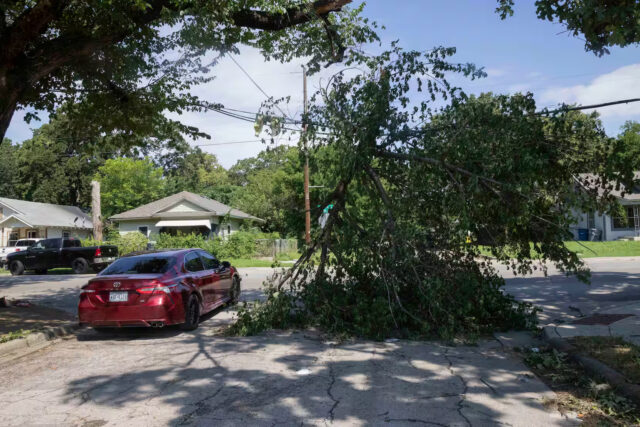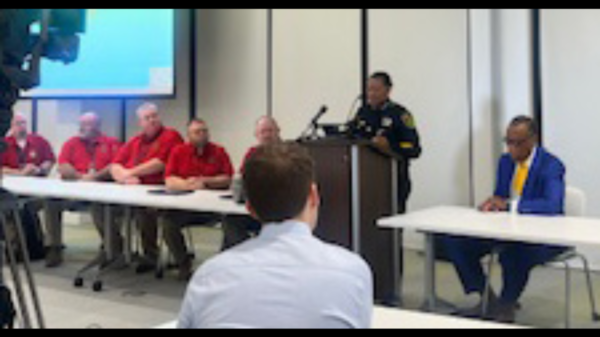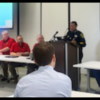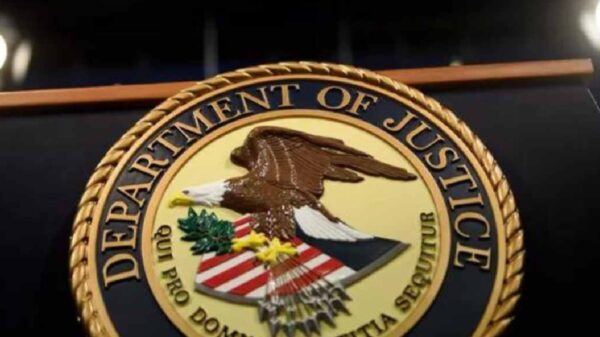
Dallas officials say they expect city cleanup of fallen trees and other debris from a Tuesday storm that hit the region and cut power for half a million North Texas homes and businesses could take at least a month to fully clear from alleys and curbs.
Brush and bulk trash collection crews may come through some heavily hit neighborhoods more than once to pick up storm debris from curbs, said Dallas Sanitation Director Cliff Gillespie. Crews will remove up to 20 cubic yards of waste for free, but residents will be billed $60 for every extra 5 cubic yards of debris that is hauled away, he said.
A cubic yard is the equivalent of a container that is 3 feet wide by 3 feet long by 3 feet high.
“Anything above that we do really recommend that folks look at other options,” Gillespie said during a city news conference Wednesday on Dallas’ storm recovery efforts. “There are private companies, waste haulers in town that handle storm debris — many of which would be able to get to some of those residents more quickly and be able to remove that debris at a lower cost than the city can.”
He also said people can haul their debris to the city’s landfill for free.
High winds and rain pounded Dallas and the metro area Tuesday, wiping out power lines and trees, blocking roadways and alleys, and damaging homes, businesses and vehicles around the city.
Close to four dozen crews are expected to work through the day and night cutting up large trees and moving them to the curb to unblock streets and alleys, said Travis Houston, Dallas’ office of emergency management director. Houston said the city has received more than 1,600 requests for service since Tuesday to its 311 non-emergency line about storm debris and blocked roads. He said as of early Wednesday afternoon, more than 980 of those requests were still open.
Around 109,000 Dallas homes and businesses remained without electricity as of early Wednesday afternoon. Across North Texas that tally is over 240,000, according to electricity distributor Oncor.
Grant Cruise, an Oncor spokesman, said it could take until Friday or Saturday to fully restore power to customers. Storm debris has blocked progress on some repairs and crews are being brought in from neighboring states to help clear the way to disrupted power lines more quickly, he said.
“Right now the damage is so widespread, we can’t point to one specific area and say it will take longer than another,” Cruise said.
Around 140 traffic signals were without power Wednesday and another 120 signals were flashing, according to Houston. He said stop signs were being put up at major intersections.
City libraries and recreation centers that still have power are open to residents to get water, air conditioning, and to charge electrical devices, he said. Residents should call specific facilities ahead of going there to make sure that they are open, Houston said.
According to a city office of emergency management report submitted to the mayor and City Council Wednesday morning, three recreation centers, the police department’s northeast patrol station, and several libraries were among city facilities still without power. Two aquatic facilities, the north central and northwest police stations, and several other facilities were reported damaged.
Dallas Fire-Rescue said they responded to more than 320 traffic accidents on Tuesday and attribute the volume to the storm. The department said they responded to around 220 crashes on Memorial Day the day before.
Residents who still require help with debris or non-emergency needs should contact 311 and only call 911 for a life-threatening emergency that requires police, fire or emergency medical service response, Houston said.
People who have damage to their homes and businesses should report it to the Texas Division of Emergency Management through its online Individual State of Texas Assessment Tool or iSTAT, he said. The survey is meant to help determine the state’s eligibility for disaster assistance and identify resource needs.
The Texas Department of Emergency Management didn’t immediately respond Wednesday to a request for comment on how many residents and businesses have completed surveys.
“Check on your neighbors. Check on your friends,” Houston said. “If you know of somebody who might need help, help them.”
Correction: A cubic yard is three feet wide, by three feet deep, by three feet tall. An earlier version of this story gave the dimensions of 20 cubic yards, which is the amount that the city will pick up for free.
This story, originally published in The Dallas Morning News, is reprinted as part of a collaborative partnership between The Dallas Morning News and Texas Metro News. The partnership seeks to boost coverage of Dallas’ communities of color, particularly in southern Dallas.









You must be logged in to post a comment Login